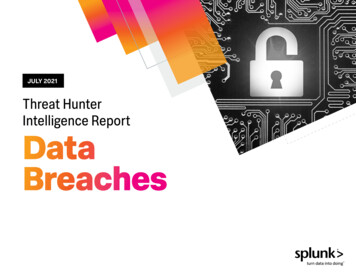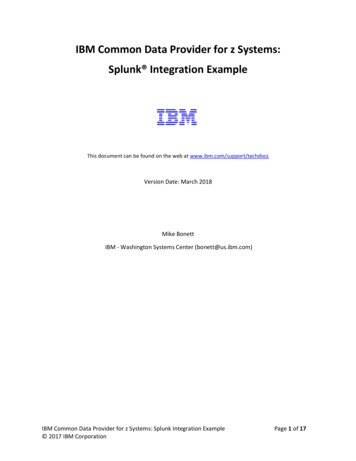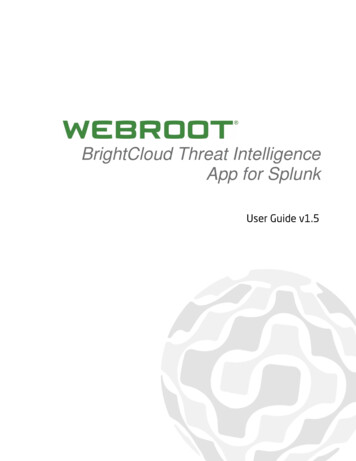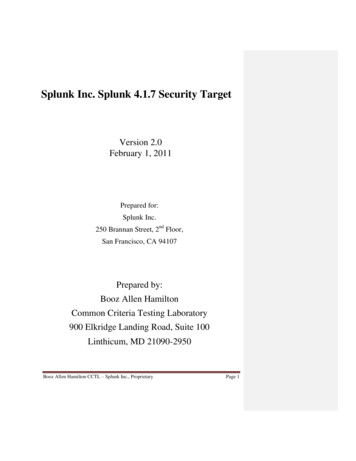
Transcription
JULY 2021Threat HunterIntelligence Report
JULY 2021Threat Hunter Intelligence Report: Data BreachesThe Threat Hunter Intelligence Report is a monthly seriesbrought to you by Splunk’s threat hunting and intelligence (THI)team. We research and produce actionable reports on the latestcybersecurity threats and trends — helping organizations stayone step ahead of adversaries, one report at a time.Data breaches 101Few data breaches compare to the massive SolarWinds hacks that left thecompany — and its roster of high-profile clients — exposed for more thannine months before detection in December 2020. During the unprecedentedattacks, foreign hackers infiltrated the Texas-based company’s network,executing malware that gave them access to sensitive information and theability to spy on tens of thousands of SolarWinds customers. The resultingdomino effect represented every security professional’s worst nightmare,raising alarms to the vulnerability of government and corporate cybersystems as more organizations fell victim in its wake.Yet even before that, data breaches were rapidly becoming moresophisticated, destructive and costly. The average cost of a breach is 150 per data record — 175 when breached via a malicious attack.And while publicly disclosed breaches fell by 48% in 2020, the numberof lost records spiked 141% to an eye-crossing 37 billion last year,evident in assaults against CAM4, BlueKai and Whisper, among others.In this report, we’ll take a closer look at the intensifying scale and impact ofdata breaches, some of the most common risks and vulnerabilities that leadto them and what CISOs can do to prevent their critical assets — and thoseof their customers — from walking out the door.Threat Hunters Intelligence Report: Data Breaches Splunk2
JULY 2021Threat Hunter Intelligence Report: Data BreachesJULY 2021Threat HunterIntelligence ReportTHI profile 1DatabasemisconfigurationChris Vickery, renowned security researcher, made a startling discovery:The personal information of almost 200 million U.S. voters was accessible toanyone on the web. A conservative data firm was hosting voter informationon an Amazon S3 server and completely messed up its configuration. Whilesome of the data on the server was protected, more than a terabyte of voterinformation was available on a public database.Researchers also recently discovered an improperly-secured MicrosoftAzure database belonging to TrueDialog, a U.S. communications firm thatprovides SMS-texting solutions. The database contained 604GB of data,including almost one billion highly sensitive data entries related to thecompany, its client base and its clients’ customers.What you need to know:Database misconfiguration is a widespread problem that can putorganizations at risk due to incorrectly configured security controls.This can happen at almost any level of the IT and security stack,ranging from the company’s wireless network and custom code toweb and server applications.This type of attack usually happens because of missing patches,use of default accounts, unnecessary services, insecure defaultconfiguration or poor documentation. For example, failing toset a security header on a web server or forgetting to disableadministrative access for certain levels of employees can leadto a data breach. These attacks can also happen when hackerstake root in legacy applications that are inherently misconfiguredbecause they haven’t been updated.Threat Hunters Intelligence Report: Data Breaches Splunk3
JULY 2021Threat Hunter Intelligence Report: Data BreachesJULY 2021Threat HunterIntelligence ReportTHI profile 2Vendor vulnerabilityCompanies often assume the risk of their vendors. An infamous example isthe Target breach in 2019 that affected over 40 million customer accounts.Investigations into the breach revealed that attackers stole the credentialsof Target’s HVAC contractor, Fazio Mechanical Services, and used that thirdparty vendor’s details to get into Target’s internal web application. Once in,hackers installed malware to capture the names, phone numbers, paymentcredit card numbers, credit card verification codes, and other highlysensitive information belonging to Target customers.This type of attack happens when a bad actor gains a foothold in the systemvia legitimate access identification — usually thanks to a stolen or spoofedvendor identity — and then moves laterally to other points of compromisewithin the system. Depending on the level of access these permissionsprovide, attackers can potentially access an entire network.What you need to know:Generally speaking, these vendor-based attacks happen due to alack of safeguards around vendors’ credentials (as well as sheerhuman folly). Hackers can also get access by spoofing login domainsor using keyloggers to steal legitimate authentication credentials.Ultimately, weak authentication methods that can be duped byexternal parties are usually the source of the problem. Vendorsand other service providers should always be vetted on theirown security controls and processes, as their security posturecan directly impact the confidentiality of customers’ data. Also,implementing a zero trust strategy can help deter bad actors,thanks to a number of ways to authenticate and authorize useridentity before granting access.Threat Hunters Intelligence Report: Data Breaches Splunk4
JULY 2021Threat Hunter Intelligence Report: Data BreachesJULY 2021Threat HunterIntelligence ReportTHI profile 3Insecure applicationsEmployees often download software onto their workstations to help themget the job done. But more often than not, these apps are installed withoutthe knowledge or consent of the organization’s IT department — andwithout the appropriate security protocols in place.Unsurprisingly, one in five organizations experience a cyber incidentoriginating from an unauthorized or insecure app. Since users accessthese apps largely under the radar, they unintentionally leave the doorwide open for malicious insiders or external hackers looking for securitygaps in these systems.What you need to know:Breaches can occur when employees upload, share or store criticalor regulated data in these apps without appropriate security anddata loss prevention (DLP) solutions. The exposed informationthen provides an easy target for insider threats and data theft, andcan also lead to costly compliance violations. In addition, the appsthemselves can be riddled with endpoint vulnerabilities (see AdobeReader for just one example of a popular app with a storied historyof security vulnerabilities).Threat Hunters Intelligence Report: Data Breaches Splunk5
WANTEDHacker profileREvilWanted for extortionREvil — a hacker group believed to be an offshootof the now-defunct GandCrab gang— are verymuch still at large. Pronounced as the letter “R”followed by “evil,” REvil has an impressive rapsheet. And while it’s hard to say where they’rebased, cybersecurity analysts suspect REvilis located in a Soviet state because the groupavoids targets in Russia and former Eastern Bloccountries. To date, the group has made countlessattempts to extort companies and public figuresby stealing their personal information. In May2020, they demanded 42 million from DonaldTrump. A week later, they released over 2GB oflegal information connected to Lady Gaga.Most recently, REvil stole plans for upcomingproducts from electronics manufacturer QuantaComputer said to include the blueprints fornew Apple laptops, an Apple Watch and a newLenovo ThinkPad. Quanta addressed the attackbut chose not to explain how it happened or howmuch of their proprietary information was stolen.REvil is now threatening to release the planspublicly unless Apple pays them a 50 millionransom fee. Until then, the hackers will continueto post new files every day, REvil said ontheir blog.Actor type:Nation state, state-sponsoredSuspected country of originand support:Russia/Former Eastern BlocMotivation:Monetary gainTargeted sectors:Technology, Financial, Manufacturing,Media, Healthcare, State and LocalGovernments, Automotive, Travel, LegalCommonly abusedtechnologies:Remote Desktop Protocol, SoftwareVulnerabilities, AdFind, Rclone, PsExec,Bloodhound, Cobalt StrikeThreat Hunters Intelligence Report: Data Breaches Splunk6
Go phishSawfishIn early 2020, Sawfish initiated a phishing attack targeting developers,cleverly duping GitHub users with a domain name and web interface thatlooked to be legitimately part of GitHub. Users received phishing emailsclaiming that their GitHub account and repositories had been compromised,leading them to a fake login form to harvest their credentials.Sawfish used a range of tactics to hide the real link destination, includingURL shorteners. They also used redirects on compromised sites withlegitimate-looking URLs to trick victims into going to malicious sites.To better prevent phishing attacks like this (which collect two-factor codes),hardware security keys or WebAuthn two-factor authentication are almostalways a safe bet. Also consider using a browser-integrated passwordmanager. Many commercial and open-source options exist, includingoptions native to popular web browsers that provide a degree of phishingprotection by only autofilling or recognizing legitimate domains where auser has previously saved a password. If the password manager doesn’trecognize the website a user is visiting, it could be a phishing site.With the stolen GitHub user account details, Sawfish then created GitHubpersonal access tokens or authorized OAuth apps in order to preserve theiraccess even when the rightful account users changed their passwords.“In many cases, the attacker immediately downloads private repositorycontents accessible to the compromised user, including those owned byorganization accounts and other collaborators,” GitHub said.Threat Hunters Intelligence Report: Data Breaches Splunk7
Looking for trouble?Stay ahead of current and emerging threats by subscribing to our monthly updateson threat hunting and investigation.Subscribe NowSplunk, Splunk , Data-to-Everything, D2E and Turn Data Into Doing are trademarks and registered trademarks of Splunk Inc. in the United Statesand other countries. All other brand names, product names or trademarks belong to their respective owners. 2021 Splunk Inc. All rights reserved.21-18892-Splunk-THI Data Breaches-EB-107
Threat Hunters Intelligence Report: ata reaches Splunk L 0(1 The Threat Hunter Intelligence Report is a monthly series brought to you by Splunk's threat hunting and intelligence (THI) . company — and its roster of high-profile clients — exposed for more than nine months before detection in December 2020. During the unprecedented










